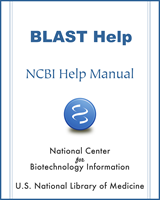BLAST is a Registered Trademark of the National Library of Medicine
NCBI Bookshelf. A service of the National Library of Medicine, National Institutes of Health.
BLAST® Command Line Applications User Manual [Internet]. Bethesda (MD): National Center for Biotechnology Information (US); 2008-.
A BLAST search against a database requires at least a –query and –db option. The command:
blastn –db nt –query nt.fsa –out results.out
will run a search of nt.fsa (a nucleotide sequence in FASTA format) against the nt database, printing results to the file results.out. If “-out results.out” had been left off, the results would have been printed to stdout (i.e., the screen). The blastn application searches a nucleotide query against a nucleotide database.
To send the search to our servers and databases, add the –remote option:
blastn –db nt –query nt.fsa –out results.out -remote
See more about this option in the section below, BLAST+ remote service.
The BLAST+ applications print documentation when invoked with the –h or –help option. The –h option provides abbreviated help, and the –help flag provides more extensive documentation. For example, use –help to get a list of output options for the –outfmt option.
Create a custom database from a multi-FASTA file of sequences with this minimal command:
makeblastdb –in mydb.fsa –dbtype nucl –parse_seqids
See the section below, Building a BLAST database with local sequences, for more details.
The BLAST databases are required to run BLAST locally and to support automatic resolution of sequence identifiers. Documentation about these identifiers can be found at http://www.ncbi.nlm.nih.gov/toolkit/doc/book/ch_demo/#ch_demo.T5. The databases may be retrieved automatically with the update_blastdb.pl PERL script, which is included as part of this distribution. This script will download multiple tar files for each BLAST database volume if necessary, without having to designate each volume. For example:
./update_blastdb.pl --decompress swissprot
will download all the relevant swissprot tar files.
The script can also compare your local copy of the database tar file(s) and only download tar files if the date stamp has changed reflecting a newer version of the database. This will allow the script run on a schedule and only download tar files when needed. Documentation for the update_blastdb.pl script can be obtained by running the script without any arguments (perl is required).
RPS-BLAST ready databases are available at ftp://ftp.ncbi.nih.gov/pub/mmdb/cdd/
The BLAST taxonomy database is required in order to print the scientific name, common name, blast name, or super kingdom as part of the BLAST report or in a report with blastdbcmd. The BLAST database contains only the taxid (an integer) for each entry, and the taxonomy database allow BLAST to retrieve the scientific name etc. from a taxid. The BLAST taxonomy database consists of a pair of files (taxdb.bti and taxdb.btd) that are available as a compressed archive from the NCBI BLAST FTP site (ftp://ftp.ncbi.nlm.nih.gov/blast/db/taxdb.tar.gz). The update_blastdb.pl script can be used to download and update this archive; it is recommended that the uncompressed contents of the archive be installed in the same directory where the BLAST databases reside. Assuming proper file permissions and that the BLASTDB environment variable contains the path to the installation directory of the BLAST databases, the following commands accomplish that:
# Download the taxdb archive
perl update_blastdb.pl taxdb
# Install it in the BLASTDB directory
gunzip -cd taxdb.tar.gz | (cd $BLASTDB; tar xvf - )
- Quick start - BLAST® Command Line Applications User ManualQuick start - BLAST® Command Line Applications User Manual
Your browsing activity is empty.
Activity recording is turned off.
See more...
